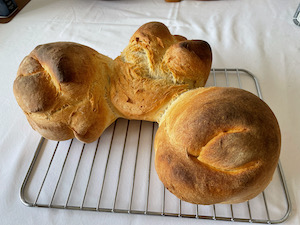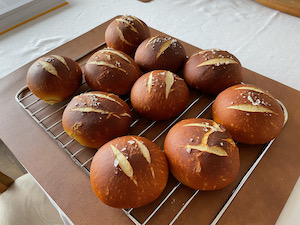Some of my tried and tested baking recipes...

St Galler Bröt
St Galler Bröt is one of my favourite breads, and this recipe adapted from Heddi Nieuwsma and Dorian Rollin's excellent book "Swiss Bread" is the version that I use. I prefer halbweiss 550 flour (rather than Ruchmehl 1100 type flour), but I understand that both are acceptable.
The poolish makes a real difference to this recipe - it adds to the flavour and I would recommend not skipping this stage. I usually make the poolish the night before and let it do its thing until the following morning. The folding of St Galler Bröt is quite important although it's a tiny bit tricky. I usually end up watching a video refresher before I get to that stage. The folding helps to give the bread its distinctive shape which in turn keeps the bread fresh for longer. Traditionally the loaves are baked in pairs, but I sometimes make three smaller loaves from this recipe which also seems to work, and means we have a loaf to give away.
Poolish
- 200ml cold water
- 200g halbweiss flour
- 2g fresh yeast
Dough
- 450ml luke warm water
- 800g halbweiss flour
- 18g fresh yeast
- 20g salt
Instructions
- Make the poolish by dissolving the yeast in the cold water and then mixing with the flour to form a wet batter. I generally use a large bowl which I will then use for the main dough mixture. Cover and leave for 15-18 hours to ferment.
- Start the dough by dissolving the yeast in the warm water, then add to the bowl along with the poolish along and the other dough ingredients and mix until a dough forms.
- Knead the dough for about 10 minutes until the dough is smooth and the gluten has developed.
- Place the dough back in the (cleaned) bowl, cover and allow to rise for about 45 minutes.
- Knock back the dough by folding in the corners, then place back in the bowl, re-cover and allow to rise again for another 45 minutes.
- Divide the dough into the required number of loaves (2 or 3). Form into smooth balls and allow to relax on a floured baking tray for 15-20 minutes before trying to shape the loaves. From this stage do not knead or fold the dough as this will cause it to tense up, making it more difficult to shape.
- On a floured surface form the shape of the loaves from each ball. Gently flatten the ball into a disc about 1-2cm thick. Then fold into in half to form a half circle. Make two angled indentations in the half circle to form three equal segments (each 1/6 of a circle). Flatten the outer two segments gently and fold over each side (left first, then right) to form a cone shape, tucking in well. Place each cone back on the floured baking sheet nearly touching and cover with a tea-towel.
- Leave the shaped loaves to prove for 15-20 minutes. This is a good time to pre-heat the oven to 220ºC using the conventional (top + bottom) mode.
- Using a sharp, wet knife, score each loaf horizontally, deeply on the front where the folds were made. This allows the loaf to rise in the oven in the correct shape.
- Bake in the oven for about 40 minutes until well risen and hollow sounding when tapped on the bottom. Cool on a rack for at least 2 hours before slicing.

Silserli
These delicious little laugen buns are always popular in our house. There's a bit of process involved in making them, but they turn out reliably good. They'll keep for a couple of days sealed in an airtight container once cooled, and are delicious with egg mayonnaise or smoked salmon.
The step of simmering the buns in the water bath / laugen solution can't be skipped as this gives the buns their final crust, however it's a bit wasteful if you're only doing a small batch. For this reason I don't bake these as often as some other breads. Dusting the baking tray very lightly with flour is quite important - too much flour and it'll stick to the bottom of the buns and then become goo in the laugen bath.
Ingredients
- 500g halbweiss (type 550) flour
- 12g salt
- 80g soft butter
- 150ml milk
- 150ml water
- 20g fresh yeast (or the equivalent dry yeast)
Water bath
- 1 l. water
- 1 tbsp salt
- 100g baking soda
Instructions
- Add the milk and water together and warm gently in the microwave until tepid. Add the yeast and allow to dissolve for a couple of minutes (dried yeast will probably benefit from a sprinkle of sugar to help activate it).
- Mix well the flour, softened butter, and salt in a bowl and create a well in the centre.
- Once the yeast has fully dissolved pour the mixture into the flour and stir until a a dough forms.
- Turn out and knead for about 10 minutes until the dough is smooth and elastic.
- Return to the bowl, cover, and allow to prove for 1-2 hours until the dough has doubled in size. Being an enriched dough this will take slightly longer than a standard bread dough.
- Divide the dough into 8 or 10 buns, shape into neat balls and place on a baking sheet lined with baking parchment which has been very lightly dusted with flour. Cover and allow to rest and rise for 30 minutes.
- Whilst the buns are resting preheat the oven to 200ºC using the conventional (top + bottom) mode, and then make the water bath by adding the salt and baking soda to water in a saucepan and bringing to a simmer.
- Once the buns are rested, place each individually into the water bath for 30 seconds on each side. Then remove from the water bath with a slotted spoon and drain well. Return to the baking sheet lined with baking parchment.
- Score the top of each bun with two parallel lines, and sprinkle with salt to give the distinctive Silserli appearance.
- Bake for 20-25 minutes, until brown and hollow sounding when tapped. Remove from the oven and allow to cool on a wire rack.

Banana Cake with Rum
One of our favourite cakes - when this turns out well it's a lovely light moist sponge with the delicate warming flavour of banana and rum. All the rum (not that much) is added right at the end - I've found that the rum cooks out completely if it's included in the batter.
Ingredients
- 140g butter, softened, plus extra for the tin
- 140g caster sugar
- 2 large eggs, beaten
- 140g plain flour
- 1/4 tsp salt
- 2 tsp baking powder
- 2-3 very ripe bananas mashed
- 8-10 walnuts roughly chopped (optional)
- 35ml good quality rum
- 50g icing sugar
Instructions
- Heat oven to 180C/160C fan/gas 4.
- Line a 2lb loaf tin with baking parchment.
- Cream 140g softened butter and 140g caster sugar until light and fluffy, then slowly add 2 beaten large eggs with a little of the 140g flour.
- Fold in the remaining flour, baking powder, salt and 2 mashed bananas.
- Pour the mixture into the prepared tin and sprinkle over the walnuts (optional)
- Bake for about 40-45 mins, or until cooked through. Check the loaf at 5-min intervals after 40 mins by testing it with a skewer (it should be able to be inserted and removed cleanly), as the time may vary depending on the shape of your loaf tin.
- Cool in the tin for 10 mins, then remove to a wire rack and drizzle over the rum
- Mix 50g icing sugar with 1-2 tsp water to make a semi-runny icing.
- Drizzle the icing across the top of the cake.

Bagels
Home made bagels which are soft and chewy on the inside covered in sesame and poppy seeds.
This recipe calls for a poolish, which is a pre-ferment that adds flavour to the final dough. It can be left out - just add the poolish and dough ingredients together - but it is worth the small amount of planning and preparation. This recipe makes 4 bagels, which will keep well for a couple of days, and up a week if sealed in an airtight container once cool. The bagels can also be frozen, although they rarely last long enough for that in our house!
Poolish
- 1/4 cup flour
- 1/4 cup water
- 2g yeast
Dough
- 120ml warm water
- 18g yeast, or the equivalent dry activated yeast
- 225g halbweis flour
- 1 tsp granulated or brown sugar
- 1 tsp salt
- Egg wash made with 1 egg white beaten with 1 tbsp water
- Optional 2-3 tbsp sesame seeds or poppy seeds for the topping.
Boiling
- 2 litres water
- 1/4 cup (60g) honey or sugar
Instructions
- Make the polish at least 6 hrs and up to 18 hours in advance. Mix the ingredients together in a bowl and cover with a warm damp towel.
- Activate the yeast in the warm water and leave for 5 minutes to dissolve fully.
- Add the flour, brown sugar, and salt and mix to form a slightly sticky dough.
- Knead by hand for 4-5 minutes, until the gluten starts to develop.
- Transfer to the bowl, cover with a damp cloth and leave to double in size (about 60 minutes).
- Once risen, knock back the dough and divide into 4 equal pieces.
- Shape each piece into a ball and then make a hole in the middle 4-5cm wide. Place on a baking tray lined with greaseproof paper and dusted with flour to prevent the bagels sticking when they’re removed.
- Leave to rest for 20 minutes whilst you prepare the water bath.
- Preheat the oven to 210ºC (conventional) or 190ºC fan assisted.
- Fill a large, wide pot with water. and whisk in the honey to dissolve. Bring water to a boil, then reduce heat to medium-high.
- Drop bagels in, one at a time and cook for about 30 seconds on each side then remove and replace on the baking tray.
- Brush the egg wash on top and around the sides of each bagel.
- Optionally top the bagels with sesame seeds or poppy seeds (any seed will do, in fact).
- Bake for 20-25 minutes, rotating the pan halfway through until the bagels are a deep golden brown.
- Remove from the oven and allow bagels to cool on the baking sheets for 20 minutes, then transfer to a wire rack to cool completely.